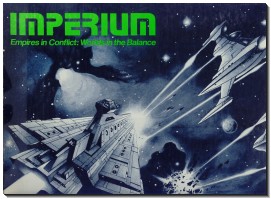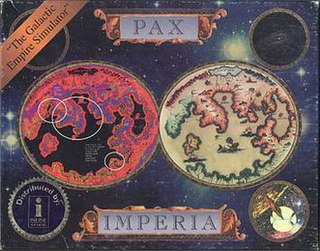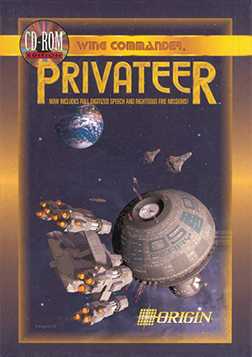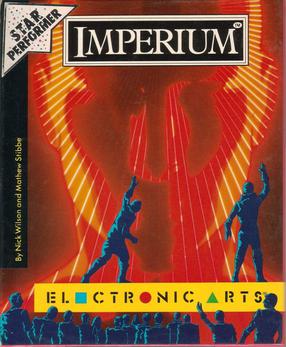
Master of Orion is a turn-based, 4X science fiction strategy game in which the player leads one of ten races to dominate the galaxy through a combination of diplomacy and conquest while developing technology, exploring and colonizing star systems.

4X is a subgenre of strategy-based computer and board games, and includes both turn-based and real-time strategy titles. The gameplay generally involves building an empire. Emphasis is placed upon economic and technological development, as well as a range of military and non-military routes to supremacy.
Renegade Legion is a series of science fiction games that were designed by Sam Lewis, produced by FASA, and published from 1989 to 1993. The line was then licensed to Nightshift games, a spin-off of the garage company Crunchy Frog Enterprises by Paul Arden Lidberg, which published one scenario book, a gaming aid, and three issues of a fanzine-quality periodical before reverting the license.

Imperium Galactica is a 4X video game, developed by Digital Reality. The same company would later make its sequel, Imperium Galactica II, in 1999. Imperium Galactica was published and distributed by GT Interactive in 1997. The soundtrack is the work of Tamás Kreiner. Nexus: The Jupiter Incident, developed by the Hungarian-based Mithis Entertainment, was originally planned and designed as Imperium Galactica 3 but in development renamed and refocussed to a real-time tactics game. The game was re-released in 2016 on GOG.com with support for Windows.

Imperium is a science fiction board wargame designed by Marc W. Miller, and published in 1977 by the Conflict Game Company and Game Designers' Workshop (GDW). It features asymmetrical forces, the two sides having its unique set of constraints. The game came in a cardboard box illustrated with a space battle on the exterior. It included a cardboard-mounted, folding map of a local region of the Milky Way galaxy, a set of rules and charts, and the 352 counters representing the various spacecraft, ground units, and markers, and a six-sided die. A second edition was published in 1990, a third in 2001, and the first edition republished in 2004.

Reach for the Stars is a science fiction strategy video game. It is the earliest known commercially published example of the 4X genre. It was written by Roger Keating and Ian Trout of SSG of Australia and published in 1983 for the Commodore 64 and then the Apple II in 1985. Versions for Mac OS, Amiga, Apple IIGS, and DOS were released in 1988.

Galactic Civilizations II: Dread Lords is a 4X turn-based strategy by Stardock for Microsoft Windows. It is the sequel to the 2003 game, Galactic Civilizations, and was released at retail and on Stardock's online subscription service, TotalGaming.net, on February 21, 2006. An expansion, Dark Avatar, was released in February 2007. A second expansion, Twilight of the Arnor, was released in April 2008.

Master of Orion II: Battle at Antares is a 4X turn-based strategy game set in space, designed by Steve Barcia and Ken Burd, and developed by Simtex, who developed its predecessor Master of Orion and Master of Magic. The PC version was published by MicroProse in 1996, and the Macintosh version a year later by MacSoft, in partnership with MicroProse. The game has retained a large fan base, and is still played online.

Spaceward Ho! is a turn-based science fiction computer strategy game that was written by Peter Commons, designed by Joe Williams and published by Delta Tao Software. The first version was released in 1990, and further upgrades followed regularly; the current version, 5.0.5, was released on July 8, 2003. It has received wide recognition in the Macintosh community, for example being inducted into the Macworld Game Hall of Fame.

Imperium Galactica II: Alliances is a video game featuring aspects of real-time tactics, real-time strategy and 4X elements from the Hungarian-based studio Digital Reality in 1999. It is the sequel to Digital Reality's previous game, Imperium Galactica. In 2016, the game was ported to iOS. The North American release is the final game to be released under the GT Interactive brand name, released shortly before Infogrames folded the label into its own studio in May 2000. In the strategy game community, it's still considered one of the all-time best Space RTS games.

Pax Imperia is a 4X game for the Apple Macintosh, released in 1992. The game won praise for its complex gameplay, real-time mode and ability for up to 16 players to join a single game using AppleTalk.

Wing Commander is the first game in Chris Roberts' space flight simulation Wing Commander franchise by Origin Systems. The game was first released for MS-DOS on September 26, 1990, and was later ported to the Amiga, CD32 (256-color), Sega CD and the Super Nintendo Entertainment System, and re-released for the PC as Wing Commander I in 1994. An enhanced remake Super Wing Commander was made for the 3DO in 1994, and later ported to the Macintosh.

Wing Commander II: Vengeance of the Kilrathi is the first sequel in Chris Roberts' Wing Commander science fiction space combat simulator franchise of computer games, produced by Origin Systems.

Lightspeed is a video game developed and released by MicroProse in 1990. It features a space flight simulator game and action game elements with an emphasis on strategy and exploration. The box describes the title as an "Interstellar Action and Adventure" game. The game features space exploration, trade, combat and diplomacy in the same vein as 4X games such as Master of Orion. Lightspeed, unlike the popular series of turn-based strategy games, plays out in real-time.

Wing Commander: Privateer is an adventure space trading and combat simulator computer game released by Origin Systems in September 1993. Privateer and its storyline is part of the Wing Commander series. The player takes the role of Grayson Burrows, a "privateer" who travels through the Gemini Sector, one of many sectors in the Wing Commander universe. Unlike Wing Commander, the player is no longer a navy pilot, but a freelancer who can choose to be a pirate, a merchant, a mercenary or any of the above in some combination. The player may follow the built-in plot but is free to adventure on his own, even after the plot has been completed.

The Cosmic Balance is a game designed by Paul Murray and published in 1982 for the Apple II and Atari 8-bit computers by Strategic Simulations (SSI). It was later released for the Commodore 64. A sequel, Cosmic Balance II, also designed by Paul Murray for SSI, was released in 1983.

Imperium is a 4X strategy video game published by Electronic Arts in 1990 for the Amiga, Atari ST, and DOS.

MegaTraveller 1: The Zhodani Conspiracy is a 1990 space science fiction role-playing video game based on the Traveller series and was produced by Game Designers' Workshop licensee Paragon Software for Amiga, Atari ST, and MS-DOS. The game is set within the Official Traveller Universe and features character creation and other aspects of game mechanics compatible with prior Traveller products. The player controls up to five ex-military adventurers whose objective is to save their civilization, the Imperium, from a conspiracy instigated by the Zhodani, a rival spacefaring race, and aided by the actions of a traitor named Konrad Kiefer. Gameplay features real-time planetary and space exploration, combat, trading, and interaction with various non-player characters in eight solar systems containing twenty-eight visitable planets.
Endless Space is a 4X turn-based strategy video game developed by Amplitude Studios and originally published by Iceberg Interactive. It was released on 4 July 2012, for Microsoft Windows and 31 August for Mac OS X. In the game, the player takes charge of fictional Space Age civilizations, expanding their influence by colonization and conquest. Endless Space sold over 1 million units, and earned the Unity Golden Cube award in 2013. The game's sequel, Endless Space 2, was released in 2017.

Imperium Galactum is a 1984 video game designed by Paul Murray and published by Strategic Simulations.


















